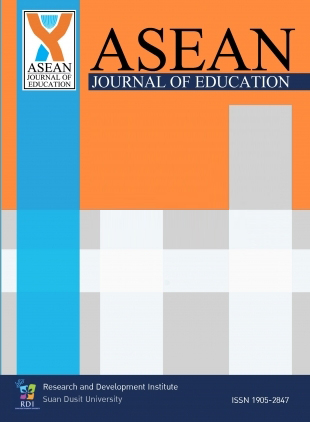Networking Model Involving Participation in Education Development: A Case of Demonstration Schools
Keywords:
Model, Network, Demonstration schoolAbstract
This study sought to create a networking model concerning participation in education development, and to assess the applicability of such a model, taking a set of demonstration schools as a case study. Informants included targeted schools’ management executives and teachers, representatives from the schools’ alumni associations and alumni members, and a group of experts, forming a cohort of 20 individuals in total. Research tools included interviews, applicability assessment, and quantitative data analyses including such statistics as mean, standard deviation, and basic quantitative analysis. Research results are as follows:
(1) Building a network that facilitates participation in education development. Our in-depth interviews seeking to create case-study-based networking model involving participation in education development found that seven components constituted common elements embodied in the cooperative networks for education development across the four demonstration schools studied. The seven common elements were: (1) mutual recognition of shared perspective with regard to the existence of the network; (2) determination of the network’s shared vision; (3) identification of the network’s shared benefits and interests; (4) identification of each network member’s involvement; (5) reciprocal network reinforcement; (6) strategic interdependence; and (7) interactive exchanges among network members.
(2) Our assessment of the applicability of the networking model involving participation in education development found that the proposed model is of high quality in all aspects. The propriety aspect had the highest mean of 4.38 and a standard deviation of 0.23, followed by the evaluation accountability aspect having a mean of 4.29 and a standard deviation of 0.23. The feasibility aspect had the lowest mean of 4.00 and a standard deviation of 0.38.
References
Charoenwongsak, K. (2012). Network management: an important strategy for the success of education reform. Management and Development Mahasarakarm University. 4(1), 192-207.
Iamdee, S., Chaiyakit, M., Ngaorangsee K., & Chanchalo. S. (2013). Development of networking management system encouraging participation in educational management: A case of Office of Primary Education District. Journal of Education Naresuan University, 15, 216-224.
Office of the National Education Commission. (2002). National Education Act of 1999 (Second Amendment). Bangkok: Phrik Wan Graphic.
Saunphakdee, B., Chatruprachiwin, C., & Chaemchoi, S. (2016). Formations of cooperative networks aimed to develop educational management in schools under the supervision of municipality. Journal of Education Naresuan University, 18(4), 99-113.
Sonsong. N., & Inrak. S. (2018). Participatory management conducted by the network for promoting the management of provincial secondary education. Suan Dusit Graduate School Academic Journal, 14(1), 115-132.
Thepkraiwan P. (2011). The development of a collaborative networking model in pursuit of quality education management in small primary schools. (Doctoral dissertation, Khon Kaen University). KKU Library.
Downloads
Published
How to Cite
Issue
Section
License

This work is licensed under a Creative Commons Attribution-NonCommercial-NoDerivatives 4.0 International License.
1 All articles will undergo a formal peer-review. A panel of experts from within or without the university will examine the article; approval from a minimum of two experts is required for publication. Revisions posed by the experts must be completed by the research prior to publication.
2 Once published in the ASEAN Journal of Education, the article becomes intellectual property of Suan Dusit University. Duplication, in full or part, requires permission from Suan Dusit University.
3 Excluding errors incurred during printing, author(s) are responsible for the content of their articles.






